Author Archive
159 Comanche Peak safety violations noted in federal report
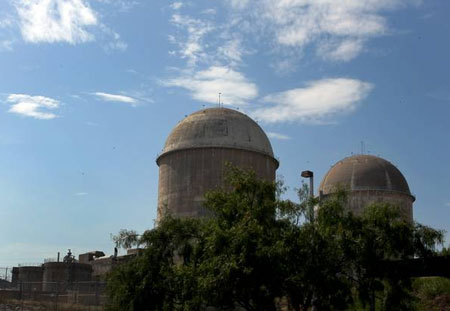
Dallas Moorning News File/Staff Photo
October 15, 2013
The Associated Press
via Dallas Morning News
The Comanche Peak nuclear power plant had 157 lower-level and two higher-level safety violations between 2000 and 2012, according to a federal report.
GLEN ROSE — An unreleased report says two Texas nuclear power plants each experienced more than 150 lower-level safety violations from 2000 through 2012.
The data were included in a Government Accountability Office report obtained by The Associated Press. It is intended to show that safety violations at nuclear plants vary from region to region, in part because of differing rules interpretations. The West region, which includes Texas, had 2 1/2 times the Southeast’s rate of lower-level violations per reactor.
The Comanche Peak plant in Glen Rose had two higher-level violations in addition to its 157 lower-level violations. The South Texas Project plant in Wadsworth had 151 lower-level and no higher-level.
Brad Wilson, a spokesman for Luminant, which owns Comanche Peak, said the company would not comment on a report it couldn’t review.
Lower-level violations pose very low risk. Higher-level violations range from low to high safety significance.
This document contains copyrighted material whose use has not been specifically authorized by the copyright owner. SEED Coalition is making this article available in our efforts to advance understanding of ecological sustainability, human rights, economic democracy and social justice issues. We believe that this constitutes a "fair use" of the copyrighted material as provided for in section 107 of the US Copyright Law. If you wish to use this copyrighted material for purposes of your own that go beyond "fair use", you must obtain permission from the copyright owner.
West Coast of North America to Be Hit Hard by Fukushima Radiation
August 20, 2013
WashingtonsBlog
Radiation Levels Will Concentrate in Pockets In Baja California and Other West Coast Locations
An ocean current called the North Pacific Gyre is bringing Japanese radiation to the West Coast of North America:
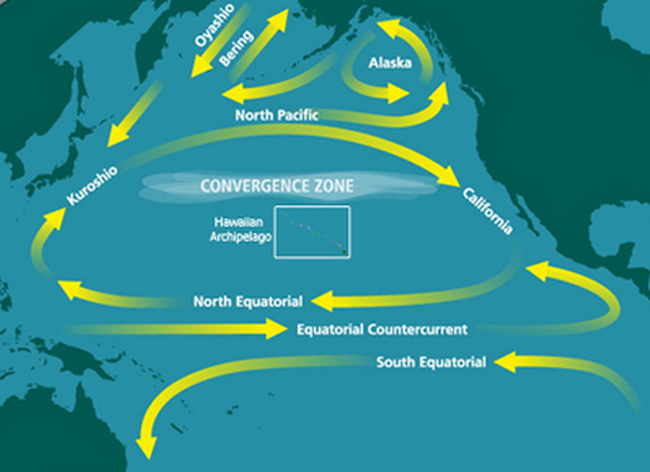
North Pacific Subtropical Convergence Zone FDA Refuses to Test Fish for Radioactivity … Government Pretends Radioactive Fish Is Safe
The leg of the Gyre closest to Japan – the Kuroshio current – begins right next to Fukushima:
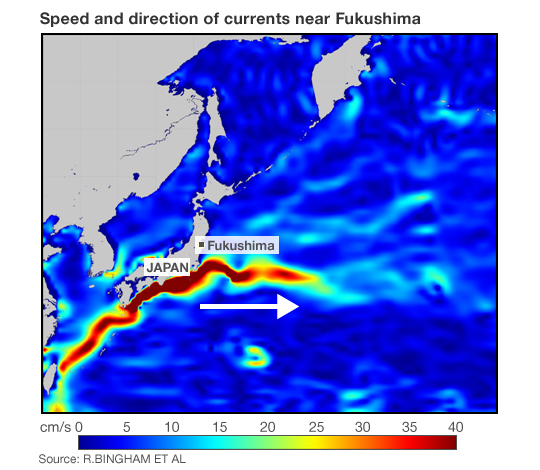
Kuroshio Current – Colour show water speed. Blue slowest; red fastest
While many people assume that the ocean will dilute the Fukushima radiation, a previously-secret 1955 U.S. government report concluded that the ocean may not adequately dilute radiation from nuclear accidents, and there could be "pockets"and "streams"of highly-concentrated radiation.
The University of Hawaii’s International Pacific Research Center created a graphic showing the projected dispersion of debris from Japan:

Last year, scientists from the National Oceanic and Atmospheric Administration’s (NOAA) Pacific Marine Environmental Laboratory and 3 scientists from the GEOMAR Research Center for Marine Geosciences showed that radiation on the West Coast of North America could end up being 10 times higher than in Japan:
After 10 years the concentrations become nearly homogeneous over the whole Pacific, with higher values in the east, extending along the North American coast with a maximum (~1 × 10-4) off Baja California.
***
With caution given to the various idealizations (unknown actual oceanic state during release, unknown release area, no biological effects included, see section 3.4), the following conclusions may be drawn. (i) Dilution due to swift horizontal and vertical dispersion in the vicinity of the energetic Kuroshio regime leads to a rapid decrease of radioactivity levels during the first 2 years, with a decline of near-surface peak concentrations to values around 10 Bq m-3 (based on a total input of 10 PBq). The strong lateral dispersion, related to the vigorous eddy fields in the mid-latitude western Pacific, appears significantly under-estimated in the non-eddying (0.5°) model version. (ii) The subsequent pace of dilution is strongly reduced, owing to the eastward advection of the main tracer cloud towards the much less energetic areas of the central and eastern North Pacific. (iii) The magnitude of additional peak radioactivity should drop to values comparable to the pre-Fukushima levels after 6–9 years (i.e. total peak concentrations would then have declined below twice pre-Fukushima levels). (iv) By then the tracer cloud will span almost the entire North Pacific, with peak concentrations off the North American coast an order-of-magnitude higher than in the western Pacific.
***
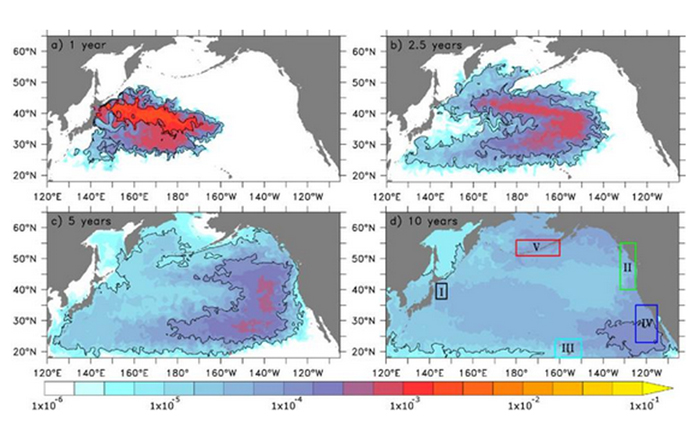
("Order-of-magnitude" is a scientific term which means 10 times higher. The "Western Pacific"means Japan’s East Coast.)
In May, a team of scientists from Spain, Australia and France concluded that the radioactive cesium would look more like this:
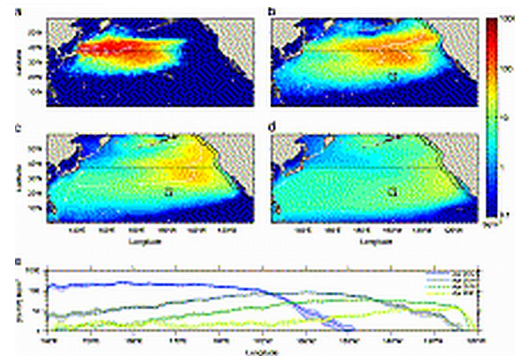
And a team of top Chinese scientists has just published a study in the Science China Earth Sciences journal showing that the radioactive plume crosses the ocean in a nearly straight line toward North America, and that it appears to stay together with little dispersion:
On March 30, 2011, the Japan Central News Agency reported the monitored radioactive pollutions that were 4000 times higher than the standard level. Whether or not these nuclear pollutants will be transported to the Pacific-neighboring countries through oceanic circulations becomes a world-wide concern.
***
The time scale of the nuclear pollutants reaching the west coast of America is 3.2 years if it is estimated using the surface drifting buoys and 3.9 years if it is estimated using the nuclear pollutant particulate tracers.
***
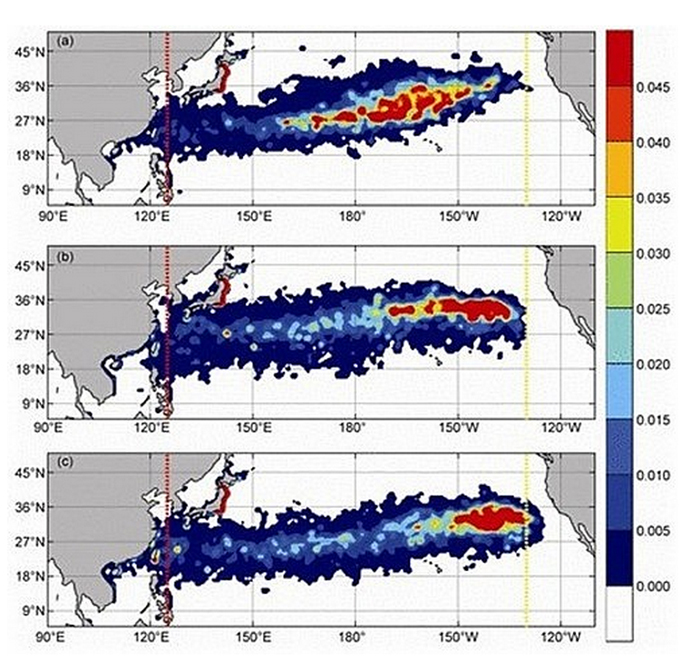
The half life of cesium-137 is so long that it produces more damage to human. Figure 4 gives the examples of the distribution of the impact strength of Cesium-137 at year 1.5 (panel (a)), year 3.5 (panel (b)), and year 4 (panel (c)).
***
It is worth noting that due to the current near the shore cannot be well reconstructed by the global ocean reanalysis, some nuclear pollutant particulate tracers may come to rest in near shore area, which may result in additional uncertainty in the estimation of the impact strength.
***
Since the major transport mechanism of nuclear pollutants for the west coast of America is the Kuroshio-extension currents, after four years, the impact strength of Cesium-137 in the west coast area of America is as high as 4%.
Note: Even low levels of radiation can harm health.
This document contains copyrighted material whose use has not been specifically authorized by the copyright owner. SEED Coalition is making this article available in our efforts to advance understanding of ecological sustainability, human rights, economic democracy and social justice issues. We believe that this constitutes a "fair use" of the copyrighted material as provided for in section 107 of the US Copyright Law. If you wish to use this copyrighted material for purposes of your own that go beyond "fair use", you must obtain permission from the copyright owner.
Entergy to Close, Decommission Vermont Yankee

August 27, 2013
For Immediate Release
Contact:
Contact:
Media Relations
Entergy
mburns@entergy.com
(802) 258-2143
Paula Waters
Entergy
pwater1@entergy.com
504-576-4380
Decision driven by sustained low power prices, high cost structure and wholesale electricity market design flaws for Vermont Yankee plant
Focus to remain on safety during remaining operation and after shutdown
New Orleans, La – Entergy Corporation (NYSE: ETR) today said it plans to close and decommission its Vermont Yankee Nuclear Power Station in Vernon, Vt. The station is expected to cease power production after its current fuel cycle and move to safe shutdown in the fourth quarter of 2014. The station will remain under the oversight of the Nuclear Regulatory Commission throughout the decommissioning process.
"This was an agonizing decision and an extremely tough call for us," said Leo Denault, Entergy’s chairman and chief executive officer. "Vermont Yankee has an immensely talented, dedicated and loyal workforce, and a solid base of support among many in the community. We recognize that closing the plant on this schedule was not the outcome they had hoped for, but we have reluctantly concluded that it is the appropriate action for us to take under the circumstances."
The decision to close Vermont Yankee in 2014 was based on a number of financial factors, including:
- A natural gas market that has undergone a transformational shift in supply due to the impacts of shale gas, resulting in sustained low natural gas prices and wholesale energy prices.
- A high cost structure for this single unit plant. Since 2002, the company has invested more than $400 million in the safe and reliable operation of the facility. In addition, the financial impact of cumulative regulation is especially challenging to a small plant in these market conditions.
- Wholesale market design flaws that continue to result in artificially low energy and capacity prices in the region, and do not provide adequate compensation to merchant nuclear plants for the fuel diversity benefits they provide.
Making the decision now and operating through the fourth quarter of 2014 allows time to duly and properly plan for a safe and orderly shutdown and prepare filings with the NRC regarding shutdown and decommissioning. Entergy will establish a decommissioning planning organization responsible for planning and executing the safe and efficient decommissioning of the facility. Once the plant is shut down, workers will de-fuel the reactor and place the plant into SAFSTOR, a process whereby a nuclear facility is placed and maintained in a condition that allows it to be safely secured, monitored and stored.
"We are committed to the safe and reliable operation of Vermont Yankee until shutdown, followed by a safe, orderly and environmentally responsible decommissioning process," Denault said.
Commenting on the future of nuclear power, Denault said: "Entergy remains committed to nuclear as an important long-term component of its generating portfolio. Nuclear energy is safe, reliable, carbon-free and contributes to supply diversity and energy security as part of a balanced energy portfolio."
Financial Implications
Entergy plans to recognize an after-tax impairment charge of approximately $181 million in the third quarter of 2013 related to the decision to shut down the plant at the end of this current operating cycle. In addition to this initial charge, Entergy expects to recognize charges totaling approximately $55 to $60 million associated with future severance and employee retention costs through the end of next year. These charges will be classified as special items, and therefore, excluded from operational results.
The company noted that the estimated operational earnings contribution from Vermont Yankee was expected to be around breakeven in 2013, and generally declining over the next few years. As a result of this decision and based on continuing operations into fourth quarter 2014, the estimated operational earnings change, excluding these special items, is expected to be modestly accretive within two years after shutdown, and cash flow is expected to increase approximately $150 to $200 million in total through 2017, compared to Vermont Yankee’s continued operation.
Regarding decommissioning, assuming end of operations in fourth quarter 2014, the amount required to meet the NRC minimum for decommissioning financial assurance for license termination is $566 million. The Vermont Yankee decommissioning trust had a balance of approximately $582 million as of July 31, 2013, excluding the $40 million guarantee by Entergy Corporation to satisfy NRC requirements following the 2009 review of financial assurance levels. Filings with the NRC for planned shutdown activities will determine whether any other financial assurance may be required and will specifically address funding for spent fuel management, which will be required until the federal government takes possession of the fuel and removes it from the site, per its current obligations.
Vermont Yankee, a single unit boiling water reactor, began commercial operation in 1972. Entergy acquired the plant from Vermont Yankee Nuclear Power Corporation in 2002. In March 2011, the NRC renewed the station’s operating license for an additional 20 years, until 2032.
Additional information regarding today’s announcement is available in the Frequently Asked Questions section of www.entergy.com.
Entergy Corporation, which celebrates its 100th birthday this year, is an integrated energy company engaged primarily in electric power production and retail distribution operations. Entergy owns and operates power plants with approximately 30,000 megawatts of electric generating capacity, including more than 10,000 megawatts of nuclear power, making it one of the nation’s leading nuclear generators. Entergy delivers electricity to 2.8 million utility customers in Arkansas, Louisiana, Mississippi and Texas.
-30-
This document contains copyrighted material whose use has not been specifically authorized by the copyright owner. SEED Coalition is making this article available in our efforts to advance understanding of ecological sustainability, human rights, economic democracy and social justice issues. We believe that this constitutes a "fair use" of the copyrighted material as provided for in section 107 of the US Copyright Law. If you wish to use this copyrighted material for purposes of your own that go beyond "fair use", you must obtain permission from the copyright owner.
TEPCO says it ‘no longer owns’ Fukushima fallout
December 27, 2011
BY:RICK WALLACE, TOKYO CORRESPONDENT
The Australian
IN terms of sheer chutzpah, Tokyo Electric Power Co’s claim that it no longer owns the radioactive isotopes that spewed out of its Fukushima Daiichi nuclear plant in March takes some beating.
In defending a lawsuit from a Fukushima Prefecture golf club, lawyers said the radioactive cesium that had blighted the Sunfield Nihonmatsu golf course’s fairways and greens was the club’s problem. The utility has taken a similarly hard line defending claims from ryokan (inn) and onsen (spa) owners.
TEPCO’s lawyers used the arcane legal principle of res nullius to argue the emissions that escaped after the tsunami and earthquake triggered a meltdown were no longer its responsibility. "Radioactive materials (such as cesium) that scattered and fell from the Fukushima Daiichi nuclear plant belong to individual landowners, not TEPCO," the utility told Tokyo District Court.
The chief operating officer of the prestigious golf course, Tsutomo Yamane, told The Australian that he and his staff were stunned: "I couldn’t believe my ears. I told my employees, ‘TEPCO is saying the radiation doesn’t belong to them’, and they said ‘I beg your pardon’."
The court rejected TEPCO’s argument, but ruled it was the responsibility of local, prefectural and national governments to clean it up.
The case – and the club’s bid for $160 million in clean-up costs – has proceeded to the High Court amid fears the ruling could result in some local governments being bankrupted.
Mr Yamane said that, before the disaster, Sunfield Nihonmatsu, about 45km west of the stricken plant, was regarded as one of the region’s finest courses and was enjoyed by about 30,000 players a year.
He said the course was showered with fallout from the accident and sections of it were now reporting readings of almost double the criteria for evacuation of 20 millisieverts a year imposed by the Japanese government for regions around the plant.
"The highest radiation amount we measured on the course was 51 microsieverts per hour (in a drain). We are getting more and more concerned about the amount of cesium on the ground," Mr Yamane said.
"Up to the end of September there was still staff working to maintain the course, but on advice from the prefectural government we had to ask them to leave."
The club launched the lawsuit after being fobbed off by TEPCO’s compensation department. Mr Yamane said TEPCO was already using the District Court judgment as a legal battering ram to fend off lawsuits from other affected golf courses in Fukushima Prefecture.
"I wonder what’s up with today’s Japan," Mr Yamane said. "TEPCO used to keep saying nuclear power was safe and kept building plants in Japan.
"If that was true, the kind of problem we are seeing now should never have occurred."
This document contains copyrighted material whose use has not been specifically authorized by the copyright owner. SEED Coalition is making this article available in our efforts to advance understanding of ecological sustainability, human rights, economic democracy and social justice issues. We believe that this constitutes a "fair use" of the copyrighted material as provided for in section 107 of the US Copyright Law. If you wish to use this copyrighted material for purposes of your own that go beyond "fair use", you must obtain permission from the copyright owner.
Texas Nuclear Reactor Restarts, Four Months After Fire
April 23, 2013
by Kate Galbraith
Texas Tribune
Four months after a fire in January, one of Texas’ four nuclear reactor units is being restarted, bringing to an end the unit’s second prolonged shutdown in two years.
"We’re bringing the unit back up," said Buddy Eller, a spokesman for the South Texas Project, the enormous Bay City nuclear plant where the problems have occurred. The 1,350-megawatt reactor unit, known as STP Unit 2, should be producing 100 percent power by sometime Tuesday, according to Eller, who spoke with the Tribune on Monday afternoon.
The fire in January occurred at a transformer in the electrical switchyard outside the reactor. The fire was fueled by oil, lasted about 10 minutes and was immediately put out by the plant’s fire brigade, Eller said.
The fire department in Bay City headed to the scene, but plant officials turned them back, saying they had the fire under control and did not need additional help, according to a representative of the Bay City Police Department.
No one was injured in the fire, according to Eller, who said that reports of 50-foot flames were "incorrect."
The cause of the fire is still under investigation, according to both the Nuclear Regulatory Commission and STP. However, Eller said it was safe to turn the unit back on.
"Our focus is to ensure that we put safety over [power] production," he said, adding that the outage had given the company time to perform additional maintenance tasks. The turbine blades and bearings were damaged when the reactor shut down quickly during the fire, he said.
It was the second major incident for STP 2 in two years. In November 2011, the reactor went down for five months after it tripped, or shut down, while it was at 100 percent power, according to an NRC web report. The cause was a malfunction of the main generator, due to a ground fault.
In neither incident was there any danger of radioactive material leaking, Eller said.
The South Texas Project plant, which began operating in the 1980s, is jointly owned by NRG Energy, which has a 44 percent stake, and two municipal utilities. CPS Energy, the San Antonio electric utility, owns 40 percent, and Austin Energy owns 16 percent. Texas’ other nuclear plant, the two-reactor Comanche Peak facility, is located in Glen Rose, near Fort Worth. The two are among the youngest nuclear plants in the country.
Environmentalists concerned about nuclear power say that the fire, in addition to the generator problem in 2011-12, has created concerns about the plant’s ability to operate safely. The federal licenses for the STP reactors expire in 2027 and 2028. Public hearings on the license extension took place in Bay City in January, just days after the fire.
"Relicensing should be halted while a serious, in-depth examination occurs," said Karen Hadden, executive director of the Austin-based SEED coalition, which advocates for sustainable energy. "I think it’s becoming increasingly unreliable, and it’s costing us money to fix it." She said it was difficult to get information about the plant’s problems.
Eller would not provide an estimate of the cost of fixing the plant. He said the plant was working through the process with its insurance company. NRG Energy said it would not discuss the cost of buying replacement power during the months that the unit was shut down, as such information is proprietary. Efforts Monday afternoon to glean cost figures from the plant’s municipal-utility owners, CPS Energy and Austin Energy, were unsuccessful.
Over the past four months, STP has taken apart the turbine generator and inspected it thoroughly, Eller said. The generator — which had been refurbished in 2012 — was fine, he said, but "we had to replace a number of the turbine blades." The two incidents were not causally connected, he said.
The NRC provided little information on the cause of the January fire; Lara Uselding, a spokeswoman, would say only that it was an "internal electrical fault on the main transformer on Unit 2." The NRC will issue a quarterly inspection report, which is publicly available, "in the May timeframe," she said. Meanwhile, "inspectors will continue their review of the root cause and would take any regulatory action if warranted," she said.
If the reactor restart is successful, it will be online in time to provide electricity during Texas’ most crucial season — the summer, when heavy air-conditioning use sends up power consumption.
"We are expecting to have STP 2 capacity available for summer needs," said Robbie Searcy, a spokeswoman for ERCOT, the Texas grid operator.
Editor’s note: An earlier version of this story said that NRG Energy operates the STP plant, in addition to owning 44 percent of it. In fact, the South Texas Project Nuclear Operating Company operates the plant. The story has been corrected.
This document contains copyrighted material whose use has not been specifically authorized by the copyright owner. SEED Coalition is making this article available in our efforts to advance understanding of ecological sustainability, human rights, economic democracy and social justice issues. We believe that this constitutes a "fair use" of the copyrighted material as provided for in section 107 of the US Copyright Law. If you wish to use this copyrighted material for purposes of your own that go beyond "fair use", you must obtain permission from the copyright owner.


